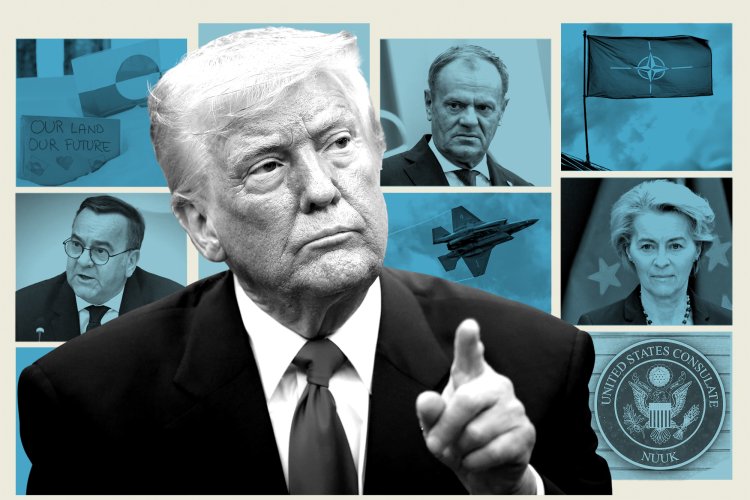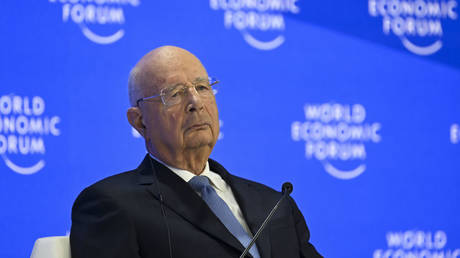From Petty Annoyances to Drastic Measures: US Allies Prepare Their Trump Retaliation Strategies
Strategies are currently being developed, and as one EU diplomat stated, “We’ll take decisions to protect ourselves."

Across Europe and beyond, discussions are intensifying about the potential responses these nations can employ.
Proposals being debated range from minor grievances to drastic measures that could jeopardize the defense and economic ties that have underpinned alliances for almost a century.
Possible actions include seeking alternative military suppliers outside of U.S.-based defense contractors, implementing stronger counter-tariffs, retracting intellectual property protections for American businesses, and reducing dependence on American technology giants. These insights come from discussions with over two dozen government officials in Europe and Canada, many of whom spoke on the condition of anonymity due to the sensitivity of the conversations.
“There’s a change in mindset. We’ve moved on from seduction to strategy,” one EU diplomat noted regarding their approach to Trump. “We’ll take decisions to protect ourselves.”
The diplomat further stated: “We need to strike a path that works without Washington.”
Less than three months into Trump's term, his transactional, mercantilist, and imperialist foreign policy has alarmed global leaders. This upheaval began with the president’s controversial remarks about annexing Canada and Greenland, his willingness to end the war in Ukraine primarily on Russia's terms, and Vice President JD Vance’s harsh remarks branding Europe as freeloaders. However, Trump's recent move to impose sweeping tariffs on almost all U.S. trading partners—based on an explanation deemed irrational by numerous economists—has caused many allies to abandon any remaining hope of managing or mitigating this unpredictable American president as they had during his first term.
Leaders from London to Warsaw, Helsinki to Rome, are striving to de-escalate tensions and preserve productive relationships with Washington, while simultaneously exploring ways to “de-risk” from Trump’s unpredictability. Their initial responses could signify the beginning of a serious shift, leading to increasingly punitive measures that might ultimately dismantle an alliance that has bound America to Europe for eight decades and reshape the global order.
The White House, however, minimized the likelihood of a rift, maintaining that Trump’s endeavors to resolve the war in Ukraine—conducted with little input from NATO allies—are intended to enhance European security. Still, many European leaders worry that any concessions made to Russian President Vladimir Putin could jeopardize their collective security.
“The President has led in an effort to bring the biggest conflict since WWII in Europe to a peaceful resolution, and he is helping restore international shipping lanes in the Red Sea that will also benefit European markets,” asserted national security council spokesperson Brian Hughes. “We will continue to work with our European allies on ways to improve security cooperation—be that through foreign military sales, encouraging our allies to increase their defense budgets, and holding our adversaries like the Houthis accountable.”
In private communications during the conflict with the Houthis, some of the president’s top advisors conveyed a perception of Europe as “free-loading,” with Vance expressing his frustration about “bailing the continent out.” “They seem to think Europe is this dying continent that has no future and is not capable of independent action, that Russia is the more formidable power,” remarked Minna Ålander, a fellow on transatlantic defense and security at the Center for European Policy Analysis. “They may soon find out that the opposite is true.”
Shifting defense dollars away from America
Few countries in Europe are as indebted or loyal to the U.S. as Poland. Yet, posters featuring the silhouettes of Putin and Trump are emerging around Warsaw, signaling a shift in public opinion and the calculations of officials in the face of recent threats and challenges from Washington.
Trump has pressured NATO members to increase their defense spending, suggesting that the alliance’s current 2% of GDP target should be raised to 5%. However, this pressure may lead NATO allies to redirect their defense investments away from American contracts, risking a critical financial arrangement essential to the U.S.
Poland, bordering Ukraine and Russia-aligned Belarus, is already spending 4.7% of its GDP on defense, the highest among NATO members, and procures more American defense equipment than any other nation worldwide. While Trump and Defense Secretary Pete Hegseth have celebrated Poland as a key ally, Warsaw is reassessing that relationship. Prime Minister Donald Tusk has ruled out canceling existing contracts but is hesitant about pursuing new ones.
“Confidence in the USA has been severely shaken,” said Pawel Kowal, the Ukraine envoy in Tusk’s office. “I don’t think we will be placing any more major orders with the American arms industry for the time being after analyzing our experiences with what is happening now.”
This statement underscores the significance of Poland’s procurement of American defense equipment in strengthening ties with Washington, particularly the Trump administration. Poland has plans to allocate $47.1 billion for defense in 2025, with over half going to U.S. contractors. However, Kowal maintains that Poland needs to “diversify our arms purchases” and “to buy in Europe or rely more on our own Polish arms industry.”
Cezary Tomczyk, Poland’s deputy defense minister, acknowledged the importance of strong ties to the U.S. but cautioned that American interests in Poland are also affected. “If the U.S. alienates Poland, it would not be good for the U.S.,” he stated.
As Trump readied to assume office for a second term, European leaders devised a strategy to keep him engaged with NATO by promising to raise defense spending, aligning most of those expenditures with American companies. Now, they are pivoting in the opposite direction.
“Europe is now going to heavily increase its investments in defense. And it will be very logical that Europe is turning this money to its own economy,” stated Estonian Foreign Minister Margus Tsahkna, while pointing to newfound questions about the reliability of American-made weapons systems that emerged after Trump abruptly halted defense aid and intelligence sharing with Ukraine in March. “There must be a political trust that if you buy something, you must be sure that you can use them as well.”
Many countries eager to boost defense spending are hesitant to invest in the U.S. defense industry—now more aware that accommodating Trump is no longer straightforward.
“In previous years, under Trump 1.0 and even afterward, we said, yes, we can appease him. He wants to make deals, he wants us to go on a big shopping spree from him: Buy F-35s, Patriots, liquefied natural gas, and all sorts of other things … and then he’ll be appeased,” remarked Peter Beyer, a member of Germany’s Bundestag from the conservative Christian Democrats, the party anticipated to lead Germany’s incoming government. “I think that’s a much too simplistic calculation. It all doesn’t add up, at least not today. It won’t work.”
Trump’s willingness to leverage U.S.-controlled weapons systems over Ukraine during wartime has raised new concerns. Countries including Canada, Portugal, Denmark, and Germany have publicly voiced hesitations about continuing to purchase F-35 fighter jets from the U.S., given that political disagreements could inhibit access to essential spare parts and software updates.
German Defense Minister Boris Pistorius committed to fulfilling Berlin’s F-35 contracts, affirming that the U.S. is “an important ally for us.” Nevertheless, he acknowledged that this decision partly stems from lacking viable alternatives for upgrading an aging fleet.
Beyer, a former transatlantic coordinator for the German government, cautioned against a heavy reliance on American security support in light of the current strategy. “If we purchase weapons systems, be it Patriot, F-35, or whatever, Lockheed Martin, Northrop Grumman, Raytheon, we have to be aware that it’s like a Damocles sword that a shutdown could occur,” he warned. “This thought is now there in people’s minds, also in connection with Starlink, Elon Musk, and the data for Ukraine — this discussion is in full swing.”
Given Europe’s deep integration into America’s defense industrial base, a swift transition to European alternatives isn’t feasible.
However, even the U.S.-made Patriot system faces competition. The French-Italian SAMP/T, which can be produced in two years, is currently being upgraded to match the range of the Patriots. Confidence in it as a viable option has increased following its extensive use in Ukraine in recent years.
Taking counter-tariffs to the extreme
On April 2, Trump imposed a 20% tariff on the EU as part of a broader strategy aimed at eliminating trade deficits, only to abruptly halt this initiative less than a week later to mitigate a global economic turmoil that was beginning to impact the U.S. bond market.
Even if this pause holds, allies still grappling with the fallout face a new chronic uncertainty.
Hours before Trump’s announcement of the tariff pause, the EU had voted to impose counter-tariffs on nearly €21 billion worth of U.S. products—including soybeans, motorcycles, and orange juice—although they refrained from retaliating against the 20% “reciprocal” tariff imposed on all EU exports to the U.S.
“Right now, Europe is focusing on customs duties in response to the duties announced by the U.S., and we aren’t looking for escalation. We don’t want to fuel confrontation, but we do want to be very clear,” conveyed one senior European diplomat.
The EU swiftly suspended its retaliatory measures following Trump’s 90-day tariff pause, but if the trade back-and-forth resumes, Europe could escalate its response further.
Discussions are underway concerning the EU’s Anti-Coercion Instrument, enacted in 2023 in reaction to China’s attempted political blackmail of Lithuania over its Taiwan stance.
This ACI, referred to by some EU officials as the “bazooka,” outlines a procedure for addressing coercion, starting with negotiations to reach a resolution. If coercion persists, the EU can escalate its countermeasures, potentially including tariff hikes and restricting access to public procurement or intellectual property protections.
Although Trump’s justification for the tariffs—promoting American manufacturing—does not appear directly coercive, the EU Commission is contemplating whether the ACI could serve as a tool in an extended trade dispute with the U.S., according to one EU official.
“It has been discussed at the European Commission level, but it’s really the nuclear option,” the official commented. “It was devised against a systemic rival [China]. You start hitting data, services, it’s a lot more imposing; you really are widening the scope. The decision is not taken, but it’s been more than just mentioned at the Commission; it’s being discussed as a possibility.”
There is a glimmer of hope that such drastic measures may not be necessary.
“The brake [on Trump] could well come from the markets,” another senior European diplomat suggested. “Europe is not defenseless.”
Targeting specific products
Certain countries and their citizens are contemplating ways to retaliate against particular American companies or industries to inflict damage or generate media attention in the United States.
Some EU governments are evaluating the possibility of weaponizing agricultural and environmental regulations to discriminate against American products, potentially banning specific items from Trump-supporting states, such as Kentucky bourbon or Florida orange juice.
Boycotting Tesla has already demonstrated this sentiment—European sales of the vehicle plummeted by 45 percent in January. Public sentiment may drive individuals to independently refrain from purchasing American products.
Across Europe, Facebook groups organizing boycotts of American products have gained tens of thousands of followers. In Denmark, a survey revealed that approximately half the population has avoided buying American goods since Trump’s inauguration, leading the largest grocery store chain to prominently display whether products are sourced from European companies on electronic price tags.
Tourism is another sector affected. Canada, along with certain other countries, has issued advisories urging citizens to “reconsider” traveling to the U.S. Passenger bookings on routes between the U.S. and Canada have decreased by 70 percent compared to the same time last year, an industry analysis predicts could result in $2 billion in lost travel and business revenue. Similarly, travel from Europe to the U.S. has dropped by 35 percent over recent months.
Should Trump implement tariffs on pharmaceuticals entering the U.S., the EU might respond with export controls—making popular medications like Novo Nordisk’s Ozempic, largely produced in Denmark, significantly more expensive for Americans.
Disrupting supply chains
Countries are also examining potential ways to limit or increase the costs of essential products and services that the U.S. depends upon.
The EU could impose export tariffs on machinery, electrical equipment, or pharmaceuticals produced within its borders, which would immediately affect U.S. supply chains. Though such a move would incur significant costs for European nations, some officials and analysts do not discount it as a possibility.
“Europe can have some chokepoints vis à vis America. Europe trades in machinery and optical equipment; we can effect a standstill of American production,” pondered Swedish economist Fredrik Erixon. “These products are not easily substitutable.”
For instance, the EU could implement export controls on products manufactured by Dutch firm ASML, the leading supplier of photolithography machines used to produce semiconductors, forcing U.S. manufacturers reliant on ASML technology—and American consumers—to incur higher costs. Other critical chokepoints could arise from high-tech products crafted by Nokia and Ericsson, which are essential to telecommunications networks.
Erixon characterized such actions as “the nuclear option” in a potential transatlantic trade conflict, given the interdependence of their supply chains. Still, he noted, “America is in a predicament because it wants to impose general tariffs, whereas the EU has the capability to reroute trade flows.”
In a notable but isolated incident, a Norwegian fuel supplier refused to refuel U.S. Navy warships and submarines after Trump and Vance criticized Ukraine’s president in the Oval Office. This episode highlighted American interests’ reliance on strong international alliances and the repercussions that could arise from deteriorating relationships.
Allies closer to home also possess levers to adjust. Canada exported 27,220,531 megawatt hours of electricity to the U.S. last year and accounted for 59 percent of American crude oil imports—a significant leverage point some leaders have noted in the event of an extended trade conflict. Recently, the premier of Canada’s largest province threatened to cut off electricity to much of New England and the Great Lakes states, insisting that Americans “need to feel the pain” from Trump’s trade war.
Simultaneously, the premier of Nova Scotia announced that American companies would no longer be eligible to bid on provincial contracts, suggesting that existing contracts could also face cancellations, explicating that, “some people need to touch the hot stove to learn.”
Sticking it to Silicon Valley
The involvement of elites like Elon Musk with the Department of Government Efficiency and the presence of various tech CEOs at Trump’s inauguration underscored how U.S. tech leaders are increasingly aligned with Trump. Previously, the EU had embarked on a course to regulate tech companies and restrain the spread of misinformation on platforms like Musk’s X. However, there was a prevailing sentiment of collaboration with the U.S. on policy and standards.
That outlook is changing.
Recently, Dutch lawmakers allocated funding for a new, domestically-controlled cloud services platform to reduce reliance on U.S. tech companies.
This followed remarks from former Belgian Prime Minister Alexander De Croo, who urged the EU to take decisive action in response to Musk’s involvement in recent European elections, where he supported far-right candidates. The EU has been investigating X for over a year and a half for potential violations of Europe’s Digital Services Act, which mandates compliance from platforms with over 45 million monthly users to protect users and curb the spread of illegal and harmful content.
Conversely, Britain is contemplating a reduction in the digital services tax imposed on tech giants, although this decision would create uncomfortable optics as the government simultaneously considers cutting welfare payments for disabled individuals.
An illustration of how countries can capitalize on their tech markets and companies crucial to the U.S. can be seen with China’s leverage over TikTok's U.S. future. Trump has been compelled to postpone implementing a law mandating that TikTok be sold to an American owner or face a ban due to Beijing’s dissatisfaction with added tariffs, which led to the collapse of a tentative agreement for American investors to gain a 50% stake.
Going it alone
Whether European or American allies proceed with the more aggressive responses under discussion, Trump’s unilateral approach and disregard for the intertwined economic and security interests embedded in longstanding alliances have intensified the urgency to reduce dependence on Washington.
Canada’s new Prime Minister, Mark Carney, summarized the sentiment sharply in response to Trump’s tariffs: “The old relationship we had with the United States, based on deepening integration of our economies and tight security and military cooperation, is over,” he asserted in late March.
The growing seriousness regarding defense spending in Europe is less about placating Trump to preserve U.S. hard power in defense of the continent and more about the realization that Europe is largely operating independently.
Hegseth and Vance have consistently communicated this message in both private and public forums.
Following his recent election, Germany’s new Chancellor Friedrich Merz emphasized his primary goal of strengthening Europe to “achieve independence from the USA,” lamenting that Trump has signaled the “Americans … are largely indifferent to the fate of Europe.”
To support this initiative, Merz successfully secured approval for the Bundeswehr to bypass Germany’s “debt brake” to significantly augment defense spending—a dramatic shift for a nation that has historically resisted militarization since World War II.
As more countries embrace this change, there is an increasing interest in forming new coalitions. Several nations in northern and eastern Europe are seeking to join the six-member Organisation for Joint Armament Cooperation (OCCAR), which manages armament programs for France, Germany, Italy, Spain, the United Kingdom, and Belgium.
Denmark, consistently contributing more to NATO defenses than many larger member states, has signed on to the European Sky Shield Initiative aimed at establishing a multi-layered air defense system.
“In three to five years, we need to be totally able to defend ourselves in Europe,” Danish Prime Minister Mette Frederiksen stated last month.
Concurrently, in the realm of trade, allies are eager to shield themselves from Trump’s erratic policies by shifting trade from the U.S. to new partnerships. French Trade Minister Laurent Saint-Martin indicated last month that Paris is reconsidering its resistance to a significant EU trade agreement with several South American nations, urging Brussels leaders to address French concerns in order to finalize the “Mercosur” deal. He characterized Trump’s “Liberation Day” announcement as a “wake-up call.”
As Trump refocused tariffs primarily on China, Beijing initiated discussions with the EU to lift the bloc's tariffs on imported vehicles from China. If successful, this agreement could significantly decrease the market share of American-made vehicles in Europe.
In the long term, Trump’s conviction that he holds the upper hand may weaken America’s position, diminishing its leverage over longstanding allies as they grow more independent from Washington.
“We need to take advantage of the crisis with the U.S. to rebuild our economic, defense, and energy sovereignty,” asserted a former French minister. “And we need to carry on hitting back.”
This analysis comes from the Axel Springer Global Reporters Network, with contributions from Eli Stokols in Washington, Philipp Fritz from Warsaw, Clea Caulcutt in Paris, and Emily Schultheis in Los Angeles.
Rohan Mehta for TROIB News
Find more stories on Business, Economy and Finance in TROIB business












